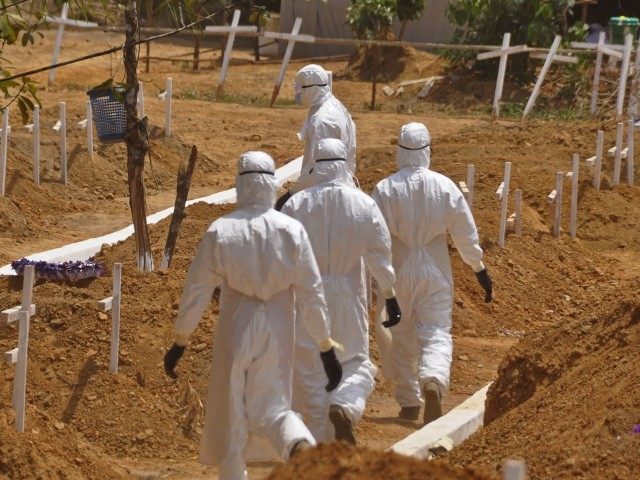The Democratic Republic of Congo has documented 19 deaths and 39 potential or confirmed cases of Ebola beginning on April 4, according to the World Health Organization (WHO), which deployed extensive medical assets to the country this week in the hope of preventing a devastating outbreak on the scale of the one that ravaged West Africa in 2014.
According to Reuters, WHO compiled its statistics between April 4 and May 13, suggesting that new cases may have been identified and confirmed between Sunday and Tuesday. The organization, along with Congolese officials and independent medical groups, has begun the process of deploying medical teams and distributing an experimental Ebola vaccine to prevent the virus’s spread.
WHO announced it has identified 393 people who made contact with those confirmed to be carriers of the disease.
Congolese officials say the cases appear concentrated in Bikoro, an area known for commercial transit, particularly of boats carrying cargo. According to the outlet Digital Congo, government officials are particularly concerned that the transit of boats along the Congo River can bring the disease into the capital, Kinshasa, where dense population centers could make it easier for the virus to spread. Deutsche Welle notes the boat transit is necessary because there is little road development in the area.
The government of President Joseph Kabila welcomed WHO Director-General Tedros Adhanom Ghebreyesus to the country on Sunday to coordinate aid distribution. The first order of business appears to be to set up mobile medical laboratories to monitor the Bikoro population. Kabila has also approved the use of an experimental Ebola vaccine, which did not exist in 2014 and is the product of extensive research done to create such a vaccine in the aftermath of the West Africa outbreak. DR Congo has four thousand vaccine doses on hand, according to local media.
Unlike in Liberia, Guinea, and Sierra Leone, there have yet to be reports of major clashes between medical aid workers and locals in Bikoro. During the 2014 outbreak, treating individuals in rural areas grew to be extremely difficult because of the spread of a rumor that Western aid workers were not treating Ebola, but actually spreading it in a campaign to kill Africans. Locals would flee from doctors wearing Western white robes or attack roving medical trucks with rocks. Some families whose relatives were being treated for the disease would steal patients from a Western-style hospital and take them to local traditional herbalists, spreading the virus further.
The near-total lack of border security among the three countries affected in 2014 also facilitated the spread of Ebola. To that end, Uganda and Kenya have already begun heightened traveler screenings for individuals coming from DR Congo and may implement further security measures to ensure no one enters the country carrying Ebola.
The Ebola virus is believed to have first infected humans in DR Congo, then Zaire, in 1976. Scientists believe that it first made contact with humans through the consumption of “bushmeat” – a catch-all term for monkeys, bats, mice, and other small animals consumed in some parts of Africa where populations have trouble securing protein-rich sources of nutrition. In 2014, a case of bushmeat consumption in Guinea is believed to have triggered an outbreak that also affected Liberia, Sierra Leone, and Nigeria that killed more than 11,300 people and affected nearly 30,000 others. The WHO declared that outbreak over in 2016, two years later.
After an initial case is documented, scientists believe Ebola is spread through human body fluids, creating the possibility of contamination through sexual contact as well as drinking from one glass or even touching a contaminated person’s sweat. In Liberia, in particular, the prevalence of elaborate funeral rites that required washing the bodies of the dead aided the spread of the virus.
The DR Congo outbreak beginning in April appears to be unrelated to that outbreak, as the virus is not believed to have the ability to live in a human body and contaminate another for more than 21 days. (WHO recommends that 42 days pass before an outbreak is declared over, twice the average amount of time the virus can incubate in a human body.) The virus is named after Congo’s Ebola River, where it is believed to have originated, and the government is typically on alert for new cases of the disease.

COMMENTS
Please let us know if you're having issues with commenting.